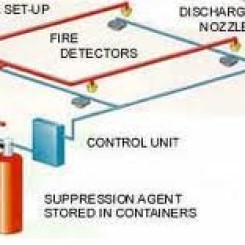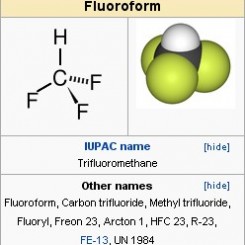Kidde HFC-23 ( FE-13 )
In response to the production phase out of Halon fire extinguishants, Kidde is now offering FE-13 (trifluo-romethane) for applications requiring immediate availability of a clean, environmentally acceptable, and human compatible fire extinguishing agent. FE-13 is a clean agent that leaves no residue, thereby eliminating costly after-fire clean-up which keeps expensive downtime to a minimum. Most materials such as steel, stainless steel, aluminum, brass and other metals as well as plastics, rubber and electronic components are unaffected by exposure to this clean agent. It has a higher vapor pressure than Halon 1301 and must be used in systems designed for these pressures. Since FE-13 contains no chlorine or bromine, its ozone depletion potential is zero. FE-13 is stored in steel containers at 609 PSIG at 70°F (42 bar at 21°C) as a liquid. The pressure of the stored agent may vary substantially with temperature changes. When discharged, the FE-13 liquid vaporizes at the discharge nozzles and is uniformly distributed as it enters the fire area.
FE-13 systems are designed for the following classes of fire:
- Class A - surface type fires (wood or other cellulose type material)
- Class B - flammable liquids (see system design manual and NFPA 2001 for guidance)
- Class C - energized electrical equipment
Performance
FE-13 extinguishes fires by both physical and chemical means. Primarily, it raises the total heat capacity of the environment to the point that the atmosphere will not support combustion. In practice, extinguishment occurs at concentrations less than the theoretical heat capacity value. This is explained by assuming that the agent also removes the free radicals which serve to maintain the combustion process. The FE-13 extinguishing concentration for normal heptane (cup burner method) is approximately 12.9% by volume versus 3.5% for Halon 1301. However, on a weight basis, when compared to Halon 1301, only 1.68 times as many pounds of FE-13 are needed for extinguishment.
Toxicity
Short term and extended inhalation studies on animals, including histologic examination, indicates that FE-13 is chemically and biologically unreactive. Although it has not been evaluated as extensively as Halon 1301, where there are comparable studies, FE-13 exhibits lesser effects. In April of 1992 DuPont sponsored a study to evaluate the cardiac sensitization potential of FE-13 in dogs. No serious arrhythmias were evoked after a five minute exposure to 30% FE-13 (and 70% air), followed by an epinephrine challenge. It is not likely that higher concentrations of FE-13 would be used for fire protection in normally occupied spaces because of excessive oxygen depletion. Nevertheless, one additional test was performed with added oxygen at 50% FE-13. Again, no serious arrhythmias were elicited. Other researchers report that 80% by volume of FE-13 did not produce cardiac sensitization in animals.FE-13 is not a mutagen in the Ames Test. When exposed to open flames, FE-13 will decompose and produce hydrofluoric acid (HF). The amount of HF will depend upon the size of the fire and the speed of the extinguishment. Even at low levels, these decomposition products have a very acrid odor and are easily detected by the human senses. The natural tendency to escape exposure should be heeded.
Approvals
FE-13 clean agent is listed as “Acceptable” without use restrictions in the U.S. Environmental Protection Agency (EPA) Significant New Alternatives Policy (SNAP) list. EPA states that FE-13 can be used wherever technical or market conditions warrant. The agent is Component Recognized by Underwriters Laboratories, Inc. (UL). FE-13 agent is included in the National Fire Protection Association (NFPA) Standard 2001, and is identified in that document as HFC-23. Kidde FE-13 engineered systems are UL Listed. Kidde FE-13 agent storage containers are U.S. Department of Transportation (DOT) approved.
request information »- Typical applications for FE-13 systems can include
- Oil and Gas
- Pumping centers
- Gathering stations
- Processing facilities
- Compressor facilities
- Turbine enclosures
- Loading/unloading
- Industry/Manufacturing
- Anechoic chambers
- Turbine enclosures
- Laboratories
- Flammable liquid storage
- Vehicles
- Locomotives
- Draglines
- Mining vehicles
- General
- Unheated spaces
- High-ceiling hazards
- Approvals
- FE-13 clean agent is listed as “Acceptable” without use restrictions in the U.S.
- Environmental Protection Agency(EPA) Significant New Alternatives Policy (SNAP) list. EPA states that FE-13 can be used wherever technical or market conditions warrant.
- FE-13 is Component Recognized by Underwriters Laboratories, Inc. (UL).
- FE-13 agent is included in the National Fire Protection Association (NFPA) Standard 2001, and is identified in that document as HFC-23.
- Kidde FE-13 engineered systems areUL Listed.
- Kidde FE-13 agent storage containers are U.S. Department of Transportation (DOT) approved.

- Bracketing
- Adapters/Misc
- Control Heads
- Switches
- Valves













